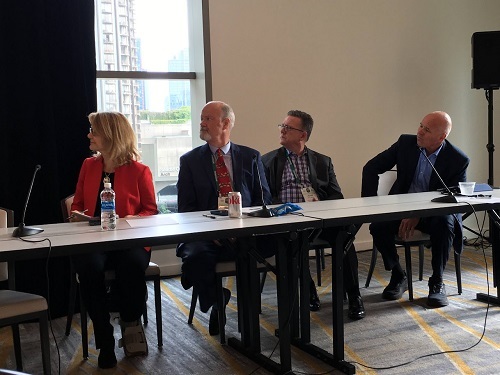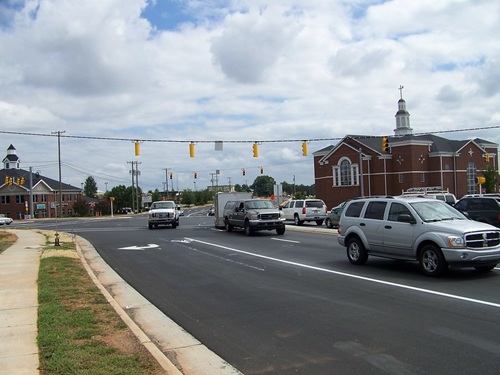The American Association of State Highway and Transportation Officials recently hosted a knowledge session, sponsored by HDR, at its 2023 Spring Meeting in Seattle that detailed the vital role state departments of transportation can play in achieving zero roadway fatalities across the United States.
[Above photo by AASHTO]
“It really has to be a collaborative and national effort; we can no longer just worry about what’s happening in our own backyard,” explained session moderator Bernie Arseneau, highways and roads director for HDR. “We also need to shift from a reactive to a proactive stance when it comes to reducing roadway fatalities – and that is not an easy shift to make; it’s one with a lot of challenges. It really means we must incorporate safety into every part of the transportation project cycle now.”
Cheryl Walker, associate administrator for safety at the Federal Highway Administration, noted that roadway fatalities have climbed in recent years despite a significant drop in vehicle miles traveled during the COVID-19 pandemic.
For example, a report issued by national transportation research nonprofit TRIP in July 2022 noted that traffic fatalities in the U.S. surged by 19 percent from 2019 to 2021, even as vehicle travel rates plummeted due to the COVID-19 pandemic.
That report – entitled “Addressing America’s Traffic Safety Crisis: Examining the Causes of Increasing U.S. Traffic Fatalities and Identifying Solutions to Improve Road User Safety” – said that spike in traffic fatalities is largely related to higher rates of “risky driving” behaviors, such as speeding and impairment due to alcohol and/or drug use.
FHWA’s Walker noted during her presentation that speed was a contributing factor in 29 percent of all vehicle deaths in 2021, so efforts to build infrastructure that slows vehicles down is critical.
“We can get to zero,” she stressed. “For example, [the town of] Carmel, IN, went to roundabouts for its traffic intersections and cut crashes by 80 percent. Meanwhile, Hoboken, NJ, went four years without a fatality due to its roundabouts. We need to put our heads together and look at ways we can do things differently.”
Robert Molloy, the director of the office of highway safety at the National Transportation Safety Board, noted that the aviation industry aimed at achieving zero passenger fatalities several decades ago and achieved that goal. “That’s why it is frustrating to watch highway fatalities go up,” he said.
Molloy added that state DOTs play an “invaluable role” in providing to his investigators information they when investigating vehicle crash scenes. “That’s information we often can’t know, because we don’t know what the crash trends are in those areas,” he said.
Most importantly, Molloy said everyone – state agencies, motorists, the private sector, etc. – must change their attitudes about vehicle crashes. “They are not inevitable,” he emphasized. “The reality is there are many things that cause crashes and there are many fixes. That’s the reason behind this whole idea of working together. It’s not one fix that will solve this.”
That’s why John Milton – director of transportation safety and systems analysis for the Washington State Department of Transportation – stressed that creating a “safety culture” within state DOTs and other transportation agencies is so important.
“We need to really think about how we design and operate roadway facilities,” he explained. “Certainly, we need to focus on improved mobility but not at the expense of safety. There are things we can do with infrastructure to reduce crashes or at least the severity of crashes – roundabout intersections, for example. But it is a shift that requires disruption, the revisiting policies, tools, and processes. It’s also about incorporating data-driven decision making and institutionalizing new approaches to safety.”
Carlos Braceras, director of the Utah Department of Transportation, also stressed at the session that it is important not to lose sight of the successes achieved every day in terms of making the nation’s transportation systems safer.
“We live by the [crash] numbers every single day and that becomes a very negative-driven conversation,” he said. “But remember, too, we are making tremendous difference even in the construction of our transportation systems.”
He added that the purpose of state DOTs is mobility – to provide transportation choices for all users to safely go where they want, when they want, and in the way that they want – and that every single activity and decision made by state DOTs today must achieve a “different balance” in terms of achieving those mobility demands in the safest way possible.
“In the end, we must be open to listening to other points of view. We need to understand what people are experiencing on the system and always challenge ourselves to look at the system in a different way,” Braceras noted. “It is totally unacceptable to have accepted what is occurring with traffic fatalities – it almost feels like we have become numb to the numbers. We can do better – and I know we will do better.”
 Top Stories
Top Stories


